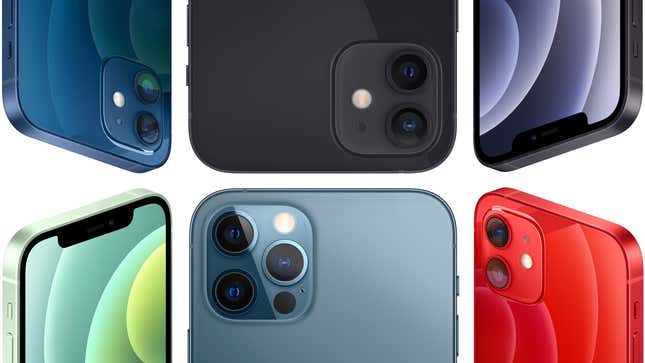
Apple’s big iPhone announcement day has finally arrived, and, as we expected, the iPhone 12 is here.
But that’s not all: Apple showed off four new iPhones, ranging in price from $700 to $1,100, and it seems like there’s something for everybody.
Starting at $800, the basic iPhone 12 is a bit more expensive than the iPhone 11, which cost $700 when it launched last year (and is actually sticking around for $600). And while the iPhone 12's screen is staying the same at 6.1 inches, for 2020 Apple is introducing new Super Retina XDR OLED panels that produce brighter and more vivid colors, up to 1,200 nits of brightness, and double the resolution of previous iPhones.
Apple has also completely overhauled the iPhone 12's design, ditching the curvy rounded sides used on previous iPhones in favor of flat edges reminiscent of the old iPhone 4 and similar to what’s available on current iPad Pros. Thanks to a partnership with Corning, Apple is introducing a new Ceramic Shield screen that’s significantly more durable then before with four times better drop performance. That said, while Apple has slimmed down the iPhone 12 Face ID system slightly, Apple’s distinctive notch is still definitely there.
Inside, the iPhone 12 will use Apple’s A14 Bionic processor, which provides faster performance and enhancements to Apple’s Deep Fusion and Night Mode photo features, along with full support for 5G across the entire line (at least in the U.S.). Apple says the six-core A14 Bionic features 40% more transistors, increasing overall performance by 50% and machine learning speed by up to 70%.

Around back, while the iPhone 12 still only has two rear cameras, Apple has added a new ultra-wide-angle camera with a wider f/1.6 aperture to capture brighter and sharper images. Apple has also added some new modes, including a new Night Mode Timelapse feature.
Meanwhile, to help make wireless charging a bit easier, Apple is introducing MagSafe for iPhone, which features a built-in magnet to center the iPhone 12 onto wireless charging pads, while also letting you attach a number of add-ons like sleeves to hold credit cards or cash. And with new wireless charging speeds of up to 15 watts, topping the iPhone 12 up wirelessly should be even faster.
However, one big change for the iPhone 12 are a couple things you won’t get in the box, including Apple’s usual power brick and wired headphones. Thankfully, you will still get a USB-C to Lighting power cable, so you won’t be totally stranded without a way to charge your iPhone.

Aside from the standard $800 iPhone 12, for anyone who thinks a 6.1-inch screen is a bit too big, Apple is also introducing the new $700 iPhone 12 Mini, which has the same specs and features as the standard iPhone 12, but with a smaller 5.4-inch display.
Of course, Apple didn’t stop there: For people who want the best tech Apple can put in a phone, there’s the $1,000 iPhone 12 Pro and $1,100 iPhone 12 Pro Max. Featuring 6.1- and 6.7-inch screens, respectively, both the iPhone 12 Pro and Pro Max feature triple rear camera modules with an additional telephoto lens and support for LiDAR.

Notably, for anyone who fancies themselves a mobile photography fanatic, the iPhone 12 Pro will have a 2x optical zoom, while the iPhone 12 Pro Max gets even longer reach with a 2.5x optical zoom. Apple also claims that the iPhone 12 Pro features 87% better performance in low light, while an improved OIS system can adjust to movement up to 5,000 times per second, five times better than what you get from the iPhone 11.
And if that’s not enough, the iPhone 12 Pro and Pro Max will also get support for Apple’s new ProRAW format sometime later this year, which will give users even more control over image quality, tone mapping, and camera settings, across all of the iPhone 12 Pro’s four cameras. On the video side, you can now also record videos in HDR, too, including support for Dolby Vision HDR recording at up to 4K resolution at 60 fps—a first for any phone.
Apple has also improved iPhone 12's LiDAR scanner to better help with autofocus in low light and to improve depth perception, even in very dark environments.
The iPhone 12 and iPhone 12 Mini will be available with 64 GB of base storage starting at $800 and $700, respectively, with options for 128 GB or 256 GB models. Both will come in five colors: black, white, red, blue, and green.

The $1,000 iPhone 12 Pro and $1,100 Pro Max will feature 128 GB of base storage (with options to upgrade to 256 GB or 512 GB), and will be available in gold, silver, graphite, and Apple’s new signature Pacific blue hue.
Preorders for the iPhone 12 and 12 Pro will begin this Friday (Oct. 16), and both will start shipping Oct. 23. The iPhone 12 Mini and iPhone 12 Pro Max will be available for preorder Nov. 6, with orders shipping out on Nov. 13.